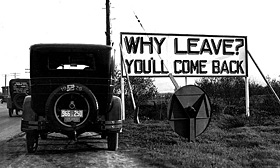 |
 |
 |
 News Around the Republic of Mexico | December 2005 News Around the Republic of Mexico | December 2005  
Mexicans Say Bush's Measures Will Do Little to Slow Immigrants
 Bloomberg Bloomberg


| | US/Mexican border sign at Tijuana, circa 1920. |
Salvador Pena squinted under the glare of a U.S. Border Protection helicopter spotlight, dragged on a cigarette and studied the 10-foot metal fence he planned to hop the next day for his fourth illegal entry from Mexico.

"I've crossed here three times already," Pena, 22, said as the helicopter buzzed past him on a routine night round. "I'm sure I can do this a few more times."

A week ago, U.S. President George W. Bush said in neighboring Arizona that he would add officers, fences, surveillance planes and sensors to the border to slow the flow of migrants. The plan will do little to deter Pena and the hundreds of thousands of other Mexicans who cross each year because of the lure of jobs that pay at least five times more than in Mexico, said analysts including Arie Hoekman at the United Nations.

"The pull from the U.S. is tremendous," Hoekman, the Mexico representative for the UN population fund, said in an interview in Mexico City. "Cutting that flow off is not going to be an easy task."

Pena, who does landscaping work in Phoenix, said he planned to escort his 19-year-old brother across from Algodones, Mexico, to Yuma, Arizona, before returning to Mexico to pick up his 2- year-old daughter and bring her across. He plans to hire a guide to help him make the trek - a 20-minute dash over a bridge followed by a five-hour hike through the rattlesnake-infested Sonoran desert - with his daughter.

`Hold the Line'

Since U.S. authorities began a crackdown on illegal immigration about a decade ago in operations known as Gatekeeper in California and Hold the Line in Texas, the number of undocumented workers crossing each year has increased by 100,000 to 400,000, according to UN and Mexican government statistics.

Bush, seeking to clamp down on illegal immigration and promote his proposal for a temporary work visa program for Mexican immigrants, said last week in trips to El Paso, Texas, and Tuscon, Arizona, that he planned to add 1,700 border patrol agents, bringing the number to 11,400 on the Southwest border.

"A temporary worker program would take pressure off our border," Bush said in El Paso, standing across from Juarez, Mexico. "It means our border patrol agents won't have to chase people coming here illegally to work - they'd be able to chase criminals and drug traffickers and crooks."

Tighter controls at the border have limited the individual crossings by Mexicans near the big cities, such as Juarez and Tijuana, and turned immigration into an organized business, said Francisco Pellizzari, a Catholic priest who runs a shelter to aid destitute migrants in Juarez.

Gangs

Gangs charge as much as $2,000 to provide transportation, a hotel room and a guided route to cross the border - often in remote desert areas where vigilance is difficult, Pellizzari said in a telephone interview. Mexicans call the guides "polleros" or coyotes.

Pellizzari said migrants used to use his 100-bed shelter as a staging point to cross on their own. Now, they use it more as a refuge as they try to raise money needed to pay a coyote and as a resting stop after being deported, he said.

"The immigration here at least in Juarez has become an arranged or professional immigration," Pellizzari said. "They are going to find new corridors to cross. The costs, the risks and the deaths are going to rise."

In 2003, 412 illegal migrants died attempting to cross into the U.S. from exposure to the southwest desert, drowning in rivers and canals and from suffocation in truck and rail cars. That is up from 371 deaths the year before, according to Mexico's Foreign Ministry.

About 12 million Mexican-natives live in the U.S. and more than half of them are undocumented, said Jeffrey Passel, senior research associate for the Pew Hispanic Center, a Washington- based non-partisan research organization.

Fox

President Vicente Fox, who has pushed for an immigration accord since he took office in December 2000 to provide amnesty for undocumented workers already living in the U.S., said he's optimistic an agreement on a temporary work program can be reached next year.

"The best thing that can happen for both our countries is to have an orderly flow" of immigration, Fox said in a news conference on Nov. 29.

Last week, Roberto Hernandez, 34, sat waiting for the sun to go down on the Mexican side of the Arizona border to attempt jumping the 10-foot metal fence after he was caught and deported the night before by Border Protection officials.

"I'll try here again tonight," said Hernandez, who traveled 36 hours by bus from his native state of Queretaro to cross Algodones, a Mexican border town near Yuma, Arizona. "If I don't make it here, I'll try crossing somewhere else."

Thomas Black in Mexico City at tblack@bloomberg.net | 
 | |
 |



